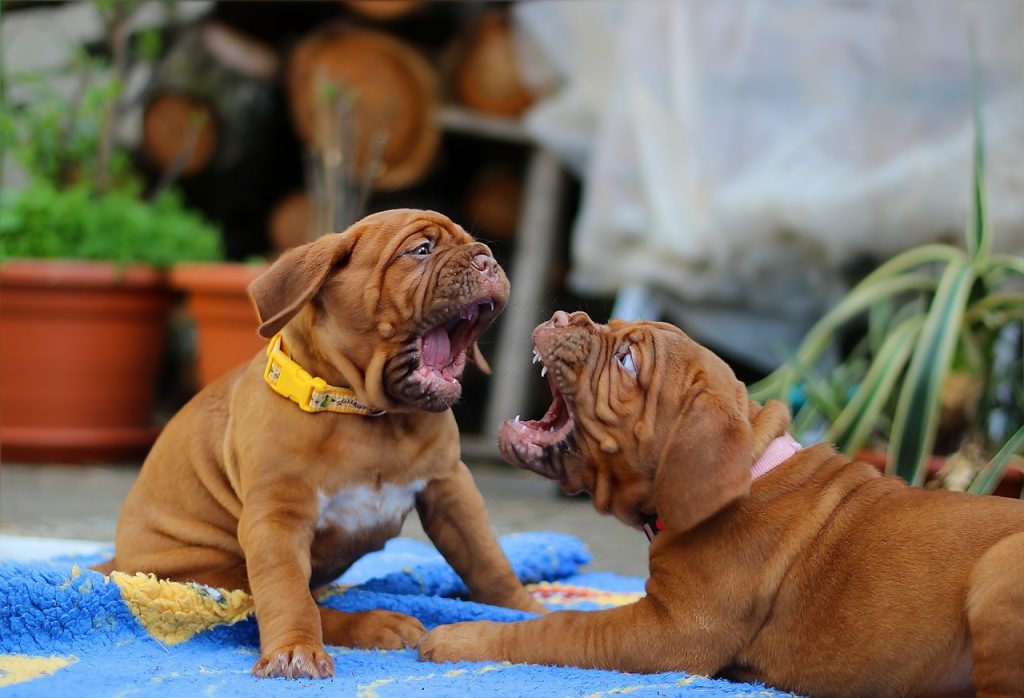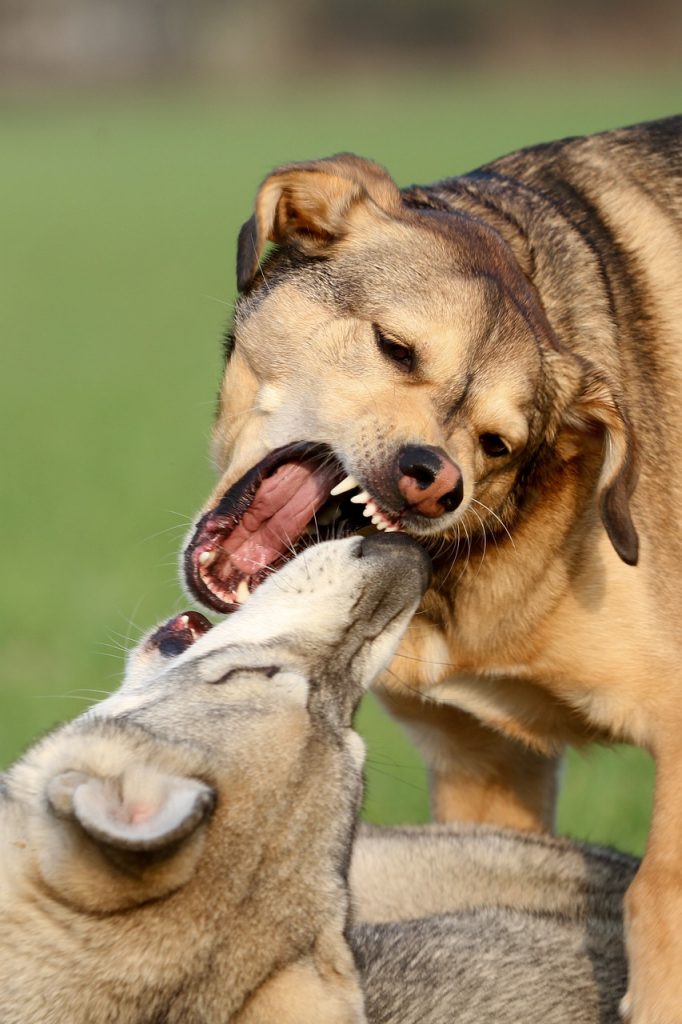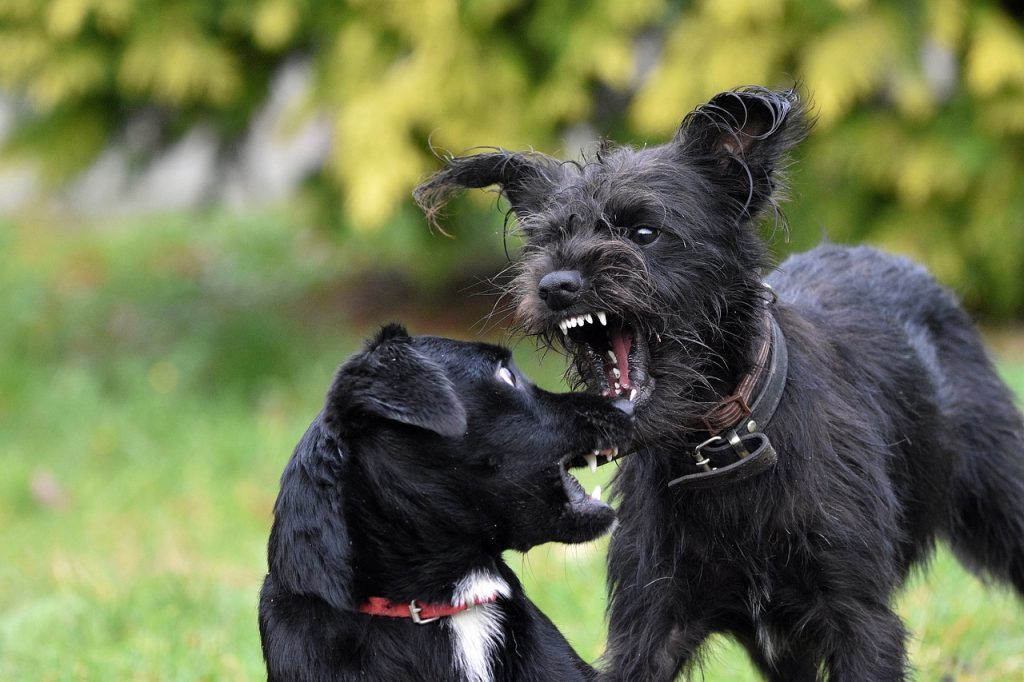Dealing with dog fights can be a distressing and challenging experience for any pet owner. It’s a common unfortunate incident that requires immediate interventions to ensure the safety of your pets, as well as necessary disciplinary actions afterward. Take a look at some of ways how to discipline a dog after fighting.
This insightful article will guide you through effective methods on how to discipline a dog after fighting, focusing on strategies such as positive reinforcement and exposing them to socialization techniques among others.
Ready? Let’s dive into creating harmony in a home shared by multiple dogs!

Key Takeaways
- Dog fights can be intense and dangerous, with signs like growling, biting, and aggressive body language indicating a serious fight.
- After a dog fight, it’s important to intervene safely using tools like brooms or water hoses and to help them calm down by giving them space and time.
- Positive reinforcement training is an effective way to discipline dogs after a fight. Reward good behavior with treats, praise, or petting.
- Consistent rules, obedience training, and socialization help prevent future fights by establishing boundaries and teaching your dog how to interact calmly with others.
- Regular exercise helps release pent – up energy and reduces the chances of fights breaking out. Provide adequate space for each dog and minimize stressful situations to create a peaceful environment at home.
Understanding Dog Fights
Dog fights can be intense and dangerous, with signs such as growling, snarling, biting, and aggressive body language indicating the seriousness of the situation.
Signs of an intense fight
Dog fights can be scary. You need to know the signs of a real fight. Dogs may show their teeth or growl loud. Their fur may stand up on end. They may stiffen their body and stare at the other dog. Ears will often go flat against their head. The dogs might also try to bite each other. Sometimes, one dog will pin another to the ground. These are all signs of a fight that is not play.

Steps to Take After a Dog Fight
After a dog fight, it is crucial to intervene safely, calm the dogs down, and conduct a thorough health check to ensure their well-being. To learn more about these steps and how to discipline a dog after fighting, continue reading.
Safe intervention
If you see your dogs fighting, it’s important to stop the fight quickly and safely. Instead of using your body, try using a broom or a chair to separate them. You can also use water from a hose to distract them and stop the fight.
It’s important to stay calm and not get in between the dogs directly. Your safety is most important, so make sure you don’t put yourself at risk when intervening in a dog fight.
Calming down
After a dog fight, it is important to help your dog calm down. Remain calm yourself and avoid getting upset. Separate the dogs using a broom, chair, or water hose if needed. Give them space and time to relax after the fight.
Regular exercise can also help reduce stress and promote peace in your home. Keep an eye on their behavior afterward as they may be traumatized or show unusual behavior. Remember to stay patient and provide comfort to your dog during this time of calming down.
Health check
After a dog fight, it’s important to check your dog’s health. Make sure to examine your dog for any injuries, such as cuts or bruises. If you notice any wounds, clean them gently with warm water and apply an appropriate antiseptic ointment.
Keep an eye out for signs of pain or discomfort, like limping or whining. If you’re unsure about your dog’s condition, it’s best to consult with a veterinarian who can provide proper medical care.
Remember to always prioritize the well-being of your furry friend after a fight.
Discipline Techniques After a Dog Fight
Implement positive reinforcement training methods to discipline dogs after a fight, focusing on rewarding desired behaviors and redirecting their aggression towards more appropriate outlets.
Positive reinforcement training
Positive reinforcement training is a great way how to discipline a dog after fighting. It involves rewarding good behavior instead of punishing bad behavior. Dogs respond well to positive reinforcement because they enjoy receiving treats, praise, and affection when they do something right.
By using positive reinforcement, you can teach your dog what behaviors are desirable and encourage them to repeat those behaviors in the future. This can help prevent future fights and create a peaceful environment at home.
Remember, consistency is key when using positive reinforcement training with your dog.
Using treats as rewards for good behavior is an effective form of positive reinforcement training. When your dog behaves well or follows commands, give them a treat immediately afterwards to show that their actions are appreciated.
You can also use verbal praise and petting as rewards, which most dogs find very reinforcing. Another important aspect of positive reinforcement training is being clear about what you expect from your dog and consistently reinforcing those expectations through rewards.
Studies have shown that positive reinforcement training results in better behaved dogs compared to punishment-based methods. It strengthens the bond between you and your furry friend while building trust and confidence in your relationship.
Positive reinforcement helps dogs associate good things with certain behaviors, making it more likely for them to choose those behaviors over negative ones.
Consistent rules
To discipline your dog after a fight, it’s important to establish consistent rules. Dogs need structure and boundaries to understand what is expected of them. By consistently enforcing the same set of rules, your dog will learn what behavior is acceptable and what isn’t.
This can help prevent future fights and promote peaceful interactions with other dogs. Additionally, having consistent rules will also make it easier for you to effectively train and communicate with your dog.
So remember, set clear expectations and stick to them for a well-behaved pup!
Obedience training
Obedience training is an important discipline technique after a dog fight. It involves teaching your dog commands like sit, stay, and come. By consistently practicing these commands, you can establish yourself as the leader and set boundaries for your dog.
Obedience training helps to redirect your dog’s focus and prevent future fights by keeping them calm and obedient. Positive reinforcement is a key aspect of obedience training, using rewards such as treats or praise to encourage good behavior.
It’s essential to be patient and consistent during this process to effectively discipline your dog after a fight.
Socialization
Socialization is an important aspect of training your dog, especially after a fight. It involves exposing your dog to different environments, people, and other animals in order to help them become comfortable and well-behaved around others.
Socializing your dog can prevent future aggression and fights by teaching them how to interact with others in a calm and controlled manner.
Regular socialization can be achieved through activities such as walks in the park or visits to dog-friendly places. This gives your dog the opportunity to meet new people and dogs while practicing good behavior.
By gradually exposing your dog to new experiences, you can help them build confidence and develop positive associations with interactions.
Moreover, socialization also includes obedience training where you teach your dog basic commands like sit, stay, come when called etc. This helps establish boundaries for their behavior and ensures they listen to you even in potentially stressful situations.
Obedience training teaches dogs how to respond appropriately when encountering other dogs or triggers that may have led to the previous fight.

Creating a Peaceful Environment
Provide a calming environment for your dog with regular exercise, adequate space, and minimizing stressful situations to prevent future aggression. Discover how neutering can play a role in reducing aggressive behavior.
Read more to find out ways to create harmony in your home.
Regular exercise
Regular exercise is an important part of keeping peace between dogs. It helps to release their pent-up energy and reduces the chances of fights breaking out. Exercise can be in the form of daily walks, playing fetch or tug-of-war, or even taking your dog to a local dog park.
Not only does regular exercise tire them out physically, but it also provides mental stimulation and socialization opportunities. By giving your dog plenty of exercise, you are helping create a peaceful environment at home and promoting harmony among your furry friends.
Adequate space
To create a peaceful environment for your dog and prevent fights, it’s important to provide them with adequate space. Dogs need enough room to move around freely without feeling crowded or claustrophobic.
This means ensuring that their living area is spacious enough for them to play, exercise, and relax comfortably. It’s also essential to give each dog their own designated space so they have a sense of personal territory.
Additionally, providing separate feeding areas can help avoid conflicts over food. By giving your dogs enough space, you can reduce the chances of territorial disputes and promote harmony in their interactions.
Minimizing stressful situations
To minimize stressful situations for your dog and prevent fights, there are a few things you can do. First, make sure to provide regular exercise for your dog. This will help them burn off energy and reduce the chances of getting into conflicts with other dogs.
Additionally, giving your dog enough space is important. Dogs need their own personal areas where they can relax without feeling crowded or threatened by others. You should also be mindful of potential triggers that may cause stress or aggression in your dog, such as loud noises or unfamiliar environments.
Lastly, consider the role of neutering in reducing aggression in dogs. Neutering has been shown to decrease territorial behavior and lessen the chances of fights occurring between dogs.
The role of neutering in aggression
Neutering can play a role in reducing aggression in dogs. When a male dog is neutered, it helps to decrease their testosterone levels, which can help reduce aggressive behaviors such as fighting with other dogs.
This is because testosterone is linked to dominance and territorial behavior. Neutering can also help prevent certain types of aggression that are driven by hormonal changes.
Female dogs can also benefit from being spayed, as it helps regulate their hormones and reduces the likelihood of aggression towards other dogs or humans. Spaying eliminates the heat cycle, which can cause shifts in behavior and make female dogs more reactive or defensive.
It’s important to note that while neutering can help with certain types of aggression, it may not completely eliminate all aggressive behaviors. Training and socialization are still necessary for managing and modifying any remaining aggressive tendencies in your dog.

Conclusion
In conclusion, disciplining a dog after a fight is important for maintaining peace and safety. By using positive reinforcement training, consistent rules, obedience training, and socialization techniques, you can help prevent future aggression.
Creating a peaceful environment through regular exercise and minimizing stressful situations also plays a crucial role in managing dog fights. Remember to remain calm when dealing with your dog after a fight, as this will help establish trust and promote healing.
FAQs
1. How should I discipline a dog after fighting?
After a fight between dogs, it’s important to separate them immediately and keep them in separate areas until they calm down.
2. Is physical punishment effective for disciplining a dog after fighting?
No, physical punishment is not recommended as it can increase aggression and fear in dogs. Positive reinforcement training techniques are more effective for addressing behavior issues.
3. Should I seek professional help to discipline my dog after fighting?
If your dogs have been involved in serious fights or if you’re unsure about how to handle the situation, it’s a good idea to consult with a professional dog trainer or behaviorist for guidance.
4. Can I prevent future fights between my dogs through training?
Yes, by implementing obedience training, socialization exercises, and providing appropriate outlets for energy and mental stimulation, you can reduce the likelihood of future fights between your dogs.


